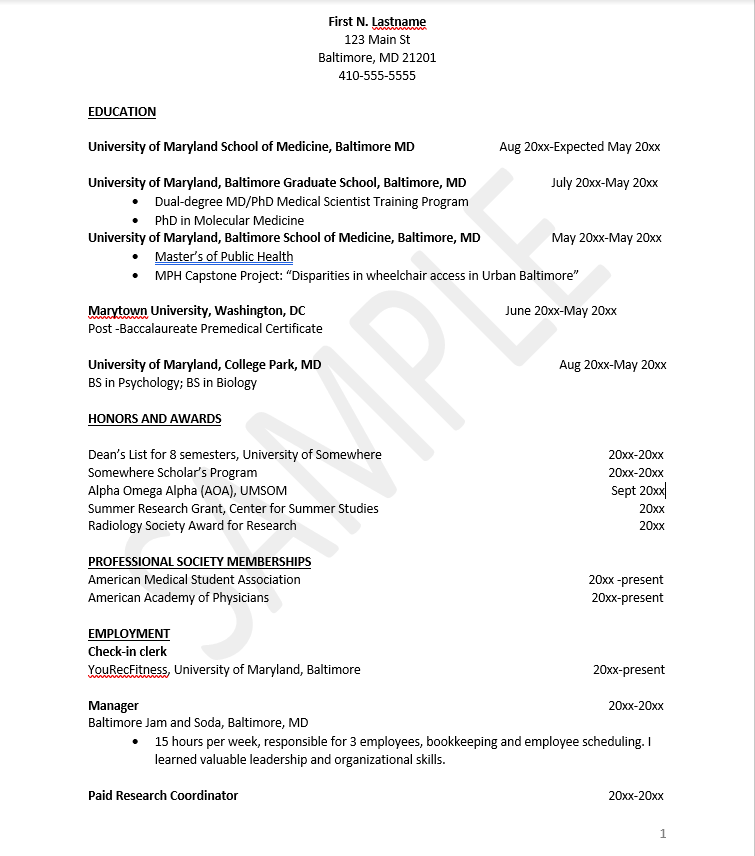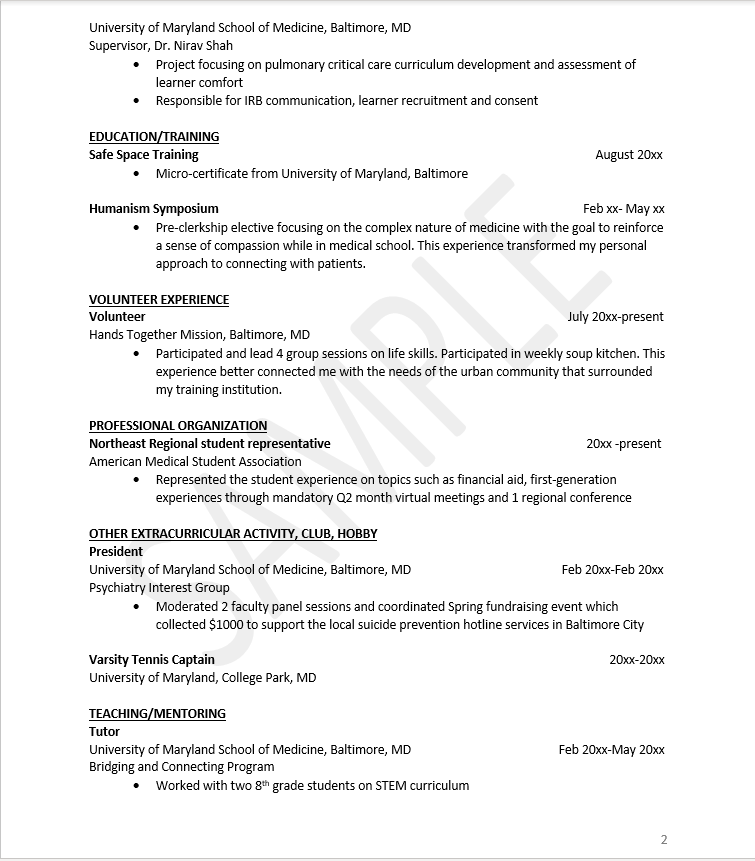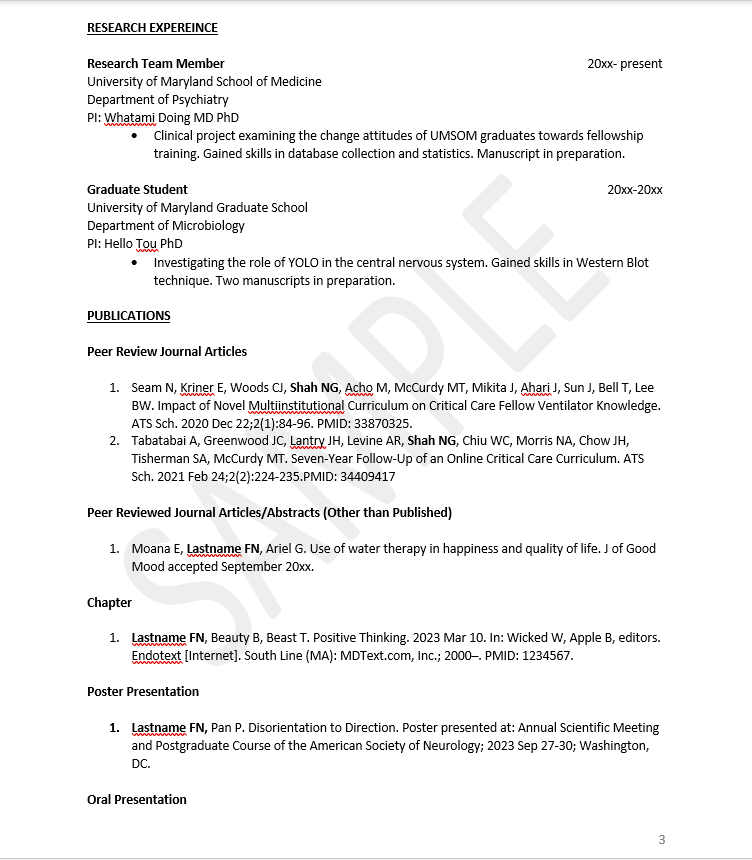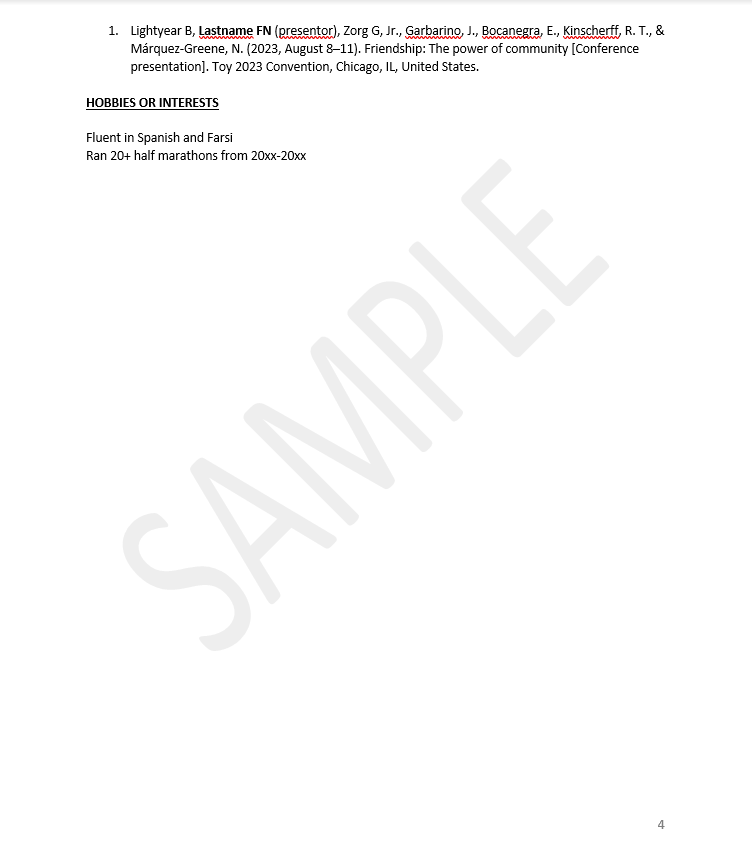Physical Address
Maintaining effective documentation of your academic history and achievements is critical to success in academic medicine. The following tools and techniques offered by the Group on Faculty Affairs can help you prepare a portfolio that highlights your unique qualifications:
CV Preparation Tips
The Curriculum Vitae is a comprehensive document of your educational background, teaching, volunteer, and research experience.
- You will find that an up-to-date CV will be helpful to apply to away rotations, make uploading information into your ERAS application easier, and for reference on the residency interview trail.
- It may also help you to identify unique characteristics to use for the MSPE.
- This document should be as long as you need it to be; especially if you have a previous career, a number of publications, or extensive volunteering etc.
- Focus on events that occurred during medical school; but that there are some parts of the CV that are “forever” like education, explaining gaps in time, and publications/presentations.
- Anything that was a significant experience and/or helps to tell your particular narrative is likely worthy of including.
- Never copy another individual’s CV. All aspects of the CV should reflect verifiable activities/information. This may be through internet searches, literature searches, etc. DO NOT risk any chance that someone viewing your CV will doubt your academic integrity.
- Reads Left to Right
- Most recent first (except Publications in chronological order)
- Standard type (Times New Roman, Calibri, Arial)
- 10–12-point font
- 1-inch margins
- Bold or italics should be used sparingly (e.g., headings or to highlight your name in a citation)
- Page Number (lower left corner)
- Use University of Maryland School of Medicine, not University of Maryland Medical School
- Do NOT include SSN, age, gender, race, religion, political affiliation, marital/parental status, disability or national origin, DEA number or license numbers
Sections: Sections and information align closely with many sections in the ERAS Residency Applicant Worksheet
Personal information
- Name (as it will appear on your application)
- Address
- Contact (phone and email)
- Should only be listed on the first page
Section Headings
Consider including 2-3 detail bullets (optional).
- Include brief description, what skill you developed or what you learned from the experience or how the experience has informed your education or perspective.
- Experiences may include month/year. ERAS has an optional section for hours/wk.
- Leadership is not an ERAS Section Experience. A standard CV could have this as a stand-alone section but for ERAS you will have to choose an available section and we encourage you to highlight that leadership position.
- Education
- For medical school, indicate that your degree is “expected (date of graduation)”
- If dual degree can place thesis as bullet under advanced degree
- Teaching certificate (could also be under employment)
- Honors and Awards
- Honors/professional societies
- Research awards or scholarships
- Employment/Work Experience
- Military Service (if appropriate)
- Education/Training
- Micro-certificate, Pre-clerkship elective, Away rotation
- Licensure (optional) (NOT BLS/ACLS but nursing/PA/EMT)
- Volunteer/Service/Advocacy Experience
- Professional Organization
- Leadership position
- Other extracurricular activity, club, hobby (optional, this would not be a standard section on a CV)
- Teaching/Mentoring
- Research Experience
- Include the institution and principal investigator
- Grant Funding and/or if you were listed as principal or co-investigator
- Publications
- Keep citation style consistent
- Bold your name
- Chronological order
- Peer reviewed means that a board of academic reviewers in the subject area of the journal, review materials for quality of research and adherence to editorial standards of the journal, before articles are accepted for publication.
- If a manuscript is in preparation, you could include this within the research description bullet. To include in the publication section could be viewed as an empty promise. See below for categories such as submitted, under review, in progress, accepted, etc.
Subsections for Publications based on ERAS worksheet:
- Peer Reviewed Journal Article/Abstracts
- Peer-Reviewed Journal Articles/Abstracts (other than published)
- (Submitted, provisionally accepted, accepted or in-press)
- Peer Reviewed Book Chapters
- Scientific Monograph (monograph is a specialist book on a single subject written by one author
- Other Articles (newspaper or newsletter articles, policy briefs, etc.)
- Poster Presentations
- Oral Presentations
- Peer Reviewed Online Publications
- Non-Peer reviewed Publications
Hobbies or Interests (optional)
-
- Generally, are bullet points. Aspects of your application such as the personal statement or noteworthy characteristics may be opportunities to expand on these topics
- Language fluency (fluent/conversational). Be able to demonstrate this skill if asked during an interview. This is also a separate section in ERAS.
- Cultural knowledge (special training or unique experience)
- Publications cited in databases (e.g. Pubmed) will provide you with the official citation.
- Generally, if a national conference calls for “original and unpublished” work, then it is poor form to present exactly the same paper/poster at another national meeting. If there is new data presented and a different poster (same project) this is generally acceptable and may be represented twice on the CV.
- Additionally, a student may present a poster at Medical Student Research Day (internal) and then submit the poster to a national conference.
- Some will combine poster presentations with abstracts as one section.
- Presentations refer to presentations that have been FORMALLY accepted or invited at regional or national academic meetings. Presentations that you do in the context of your education, for instance on rounds or in clerkship conferences, etc. are NOT academic presentations and should not be listed on your CV.
- Presented at Virtual conference: https://style.mla.org/paper-presented-at-virtual-conference/
- Presentation at a Cancelled Conference: https://style.mla.org/presentation-canceled-conference/
- A glitzy appearance
- Using a passive voice or first person; instead use an active voice
- “The research investigates the relationship between X and Y” (active) versus “The research was investigating the relationship between X and Y” (passive)
- Not spell checking and proof-reading
- Not accounting for gaps in time: People look for holes in your life, and there should be no extended period of time unaccounted for. It is better to say that you worked for a year (and what’s wrong with that?) than to have them wonder where you might have been during that time.
- Not including Pre-college achievements (e.g., high school valedictorian, Eagle Scout) which may be relevant
- Not including leadership, volunteering and sports activities from undergraduate years
- Listing hobbies that would show a Program Director that you may be distracted (e.g., playing video games, fantasy football, etc.) or ensure that these hobbies are placed in context
If you are not sure where an activity, publication or article should be listed, talk to your research mentor, specialty advisor, and/or your career advisory dean.
You can also submit questions to the HS/HSL library [link https://answers.hshsl.umaryland.edu/]
Sample CV
© University of Maryland School of Medicine, 655 W. Baltimore Street, Baltimore MD 21201
Preparing Your Curriculum Vitae

Maintaining effective documentation of your academic history and achievements is critical to success in academic medicine. The following tools and techniques offered by the Group on Faculty Affairs can help you prepare a portfolio that highlights your unique qualifications:
- Create My CV is a template to craft your CV.
- Tips and Strategies on how to make the best impression;
- Teaching Portfolio explains what should be included when showcasing your teaching efforts; and
- Biographical Sketches, Statements, and Executive Summaries includes information about your biographical statement and links to the NIH Biosketch form and examples. It also addresses the “Executive Summary,” a powerful tool to highlight your qualifications in ways that one’s CV often does not.
Key points to keep in mind
Follow your institution’s guidelines for your internal CV, the CV you submit with promotion and tenure materials.
- Be proactive in creating your external CVs, biographical statements, and executive summary;
- Create a teaching portfolio; and
- Develop a system that works for you to facilitate updating your package.













